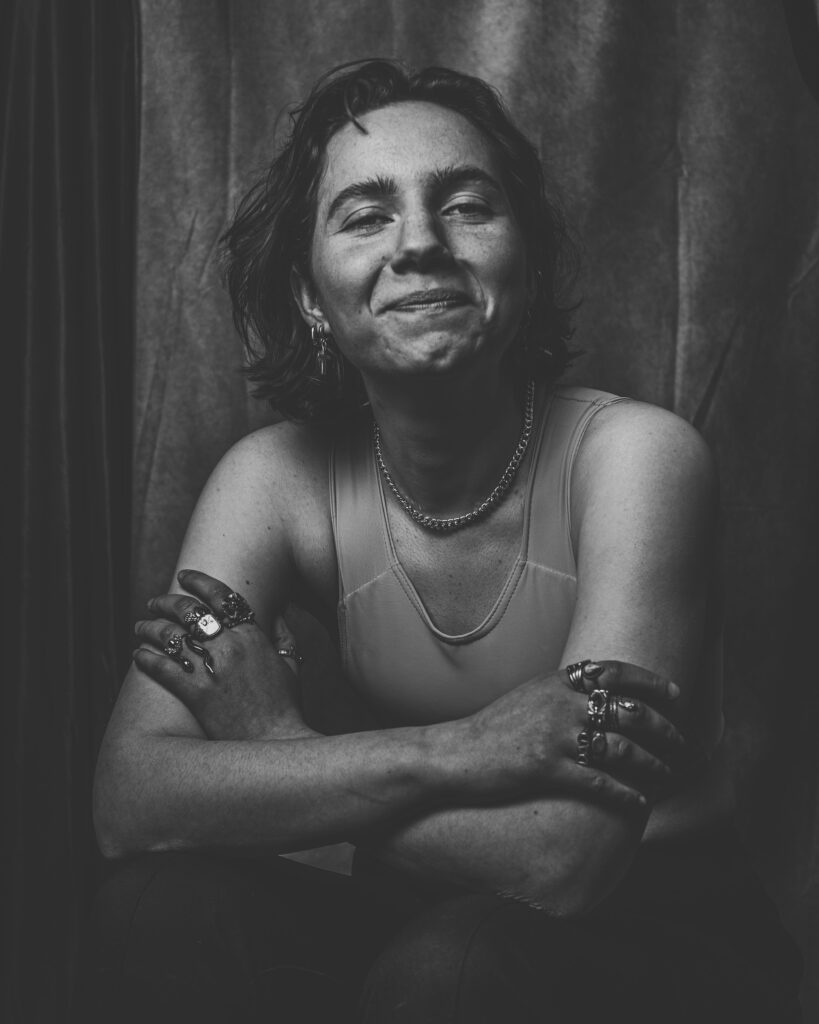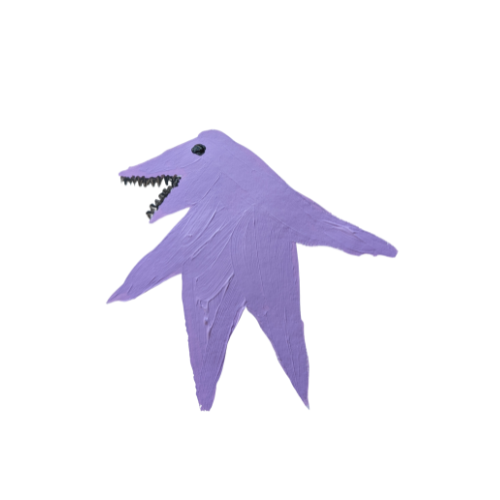
In January 2023 I started a conversations project during my residency at Applecart Arts. I sit down and have a conversation of approximately one hour with someone I am interested to have a conversation with. Whilst there might be particular things I am interested in, I don’t have questions planned in advance and what happens is organic. Whilst we talk, I paint. What I share here is the painted/drawn outcome of the conversation. Afterwards, I write up my reflections which come from the conversation. Then, they go into my gallery of conversations, which you have found yourself in here…
Hannah Williams is a spatial and performance designer as well as an artist and maker. They designed the interior of the Applecart cafe, where my residency is taking place and where I spend most of my time when I am there. I love going in there, it’s this wonderful rare mix of cosy and spacious. I’d planned for us to talk for half an hour but we actually ended up speaking for two hours. They assured me that this was okay but I felt a bit embarrassed that I’d taken up so much of their time. Hannah also works in the cafe at Applecart.
It was an unusual experience to be having a conversation with someone, being surrounded by their work and ideas. Also, behind Hannah was an installation they had done for the Jack and the Beanstalk panto, where they had, enlisting people in the local area, turned a room into an immersive dreamy beanstalk experience. They had also got people to bring along fabric so minimal new materials were needed. We met in early January, before I headed to Ocracoke for the residency/art adventure. I found it useful to have this conversation before I left as it was on my mind whilst I was on the island where the things we talked about were also very relevant.
Hannah is from Hastings, a town on the south coast of England, and they told me about what it was like growing up there. During our conversation, I kept thinking about living by the sea and how appealing it is. They told me about some of the characters of Hastings, which included a man who dressed up in Popeye cosplay as their regular day-to-day clothing and someone else who would walk around the streets playing the bongos at 2 am. We talked about how being known, even for doing things outside of the norms of societal behaviour is more likely to happen in smaller places. From my experience, small towns always have these “characters” which are part of the place.
In the town I grew up, there was a man who was known as Ginger, a really tall man with a ginger beard who always wore (in public) military fatigues. He was often seen in the pub, pretty much always quiet, sometimes reading a book. He was seen as his “character” rather than for his humanity as someone who was similar, that we might have similar interests as and could interact with. As far as I know, he wasn’t harassed by people (though I would be surprised if this never happened) but he was also kept at arms length.
In London, it can be hard to get to know your own community or even recognise people day to day (or be known or recognised). I moved to Manor Park during a covid lockdown in 2020 and I only started having longer interactions with people around me when I got a puppy and people would stop to ask about her. I once had an hour-long conversation on my way to the park, with a man sitting in his car with the door open. he was waiting for his friend who he supports in day-to-day tasks. He’d grown up in the area in the 60s. He talked about his experiences of being a Black man in this area, over the past decades. He told me about the Staffordshire bull terriers that he walks every day for a friend and how if I see him coming with the dogs he’ll avoid me as they aren’t good with other dogs. I met other dog owners and generally learnt the names of their dogs rather than the human’s names.
But apart from these brief interactions, I didn’t really get to know people around here, until I started running stalls at makers markets at the end of December last year (2022), particularly in Manor Park and Forest Gate. It was by joining these markets that I met other local artists and got chatting to people who live in the area. It felt really, really good. And, we were connecting in part because I was sharing parts of myself through the things I had made!
After an evening Christmas market I stayed to have a drink with some people who lived nearby. We talked about things going on in the area and had a little gossip. I was invited to the Manor Park Village email list where lots of different local stuff is shared. The next morning, I woke up feeling claustrophobic that people near where I lived, knew me. This was something I’d wanted for two years and now I felt trapped that people might recognise me and know stuff about me. The feeling passed but I find that so fascinating and funny – how we can think we want something SO much and when it happens we can have such a strong alternative reaction.
Then, going to Ocracoke, I was temporarily part of a community where I would be “known”. We were told before we got there that people would know that we had arrived. After being there for a week, Steve was referred to as “the man who rides around on a bike, wearing all black.” After that point, he he would try and add some colour to his clothes. I sometimes felt very self-conscious about how I came across to people (and I was just guessing what they might be thinking about me!) I was feeling pressure about meeting people and I only had two weeks to make some meaningful interactions happen! One night, Steve and I went out for a meal in an exceptionally-full restaurant and we were the only people who weren’t duck hunters, where our difference/outsiderness was even more pronounced.
So, on this island, I was more obviously different. That is actually somewhat similar to my neighbourhood, which is has a significant Pakistani and Indian community – when I’m walking around my neighbourhood white people stand out as ‘different’ to me. As a white woman living in the UK, I’ve rarely been part of the minority (and in the broader sense I always remain part of the majority). When I lived in a town in China people would stop and ask me what I was doing there, because I was one of two caucasian people living in a town with a population of over 300,000. This makes me think about how we can be more and less aware of our own difference to the people around us – and we never really know how we are being perceived.
I guess all of these thoughts are reflections of being known and unknown. On being different. Thinking about connecting with other people. How being known and recognised can help connection and make it harder when people have attached a label to you. If we see other people as the labels we give them or they prescribe to themselves, what do we gain and what do we lose? It might help us in the short term, in making shortcuts and meaning (which might turn out to be more or less accurate) but it can also lead to lost opportunities to connect and learn.

To know more about Hannah’s work, you can check out their website here or head to their Instagram here.

